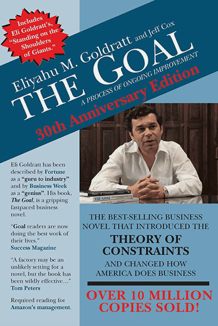
Eliyahu M. Goldratt was an Israeli physicist, business consultant, and author who revolutionized the field of business management with his Theory of Constraints (TOC) framework. Born in Israel in 1947, Goldratt studied physics and received his Ph.D. from the Technion, Israel's Institute of Technology. He then moved to the United States and began working in the field of business management. Goldratt's breakthrough came in the early 1980s with the publication of his book, "The Goal," which introduced the world to the Theory of Constraints.
The Theory of Constraints is a framework for identifying and resolving bottlenecks in business processes. The theory holds that every system has at least one constraint, which is the factor that limits its performance. By identifying and resolving these constraints, businesses can improve their efficiency and profitability. Goldratt's approach was revolutionary because it challenged traditional management thinking, which emphasized maximizing the efficiency of each component of a system rather than the system as a whole.
Goldratt's contributions to the field of business management did not go unnoticed. He was awarded numerous honors and accolades, including the title of "Father of the Theory of Constraints." Countless businesses around the world have adopted his ideas, and his books have been translated into dozens of languages.
But Goldratt's impact went beyond business management. He was a visionary thinker who believed that his ideas could be applied to solve some of the world's most pressing problems. He wrote about the potential of the Theory of Constraints to improve healthcare, education, and even the global economy.
Goldratt's influential business novel left a lasting impression on Drew Greenblatt, Marlin Steel Wire President. Reading "The Goal" helped Greenblatt refocus his business and product offerings at a time when the Atkins diet popularity was soaring and demand fell for the company's wire bagel baskets. As chairman of the Regional Manufacturing Institute (RMI) in Baltimore in 2011, Greenblatt decided to invite the author to talk about his theories.
Goldratt visited RMI on April 14, 2011, giving a speech about the benefits of maximizing ROI rather than simply completing projects and the importance of developing human relationships and trust amongst your workforce. Greenblatt introduced Goldratt at the event as the man who "saved our company." Goldratt was so touched that, afterward, the author asked Greenblatt to join him in his limo. Goldratt used the ride to dissect Marlin's operations with Greenblatt and provide numerous suggestions for improvements.
Sadly, this would be Goldratt's last speech, as he passed away from cancer in 2011 shortly after his return to Israel, but his legacy lives on. His ideas continue to inspire new generations of business leaders and thinkers. At Marlin Steel Wire, we are proud to be part of the Goldratt legacy. Our commitment to continuous improvement and innovation is rooted in Goldratt's ideas, and we strive to apply his principles every day in our work.
The Theory of Constraints: A Powerful Tool for Business Success
The Theory of Constraints is a powerful tool for improving business performance. By identifying and resolving bottlenecks in a system, businesses can improve their efficiency, reduce costs, and increase profitability. But how does the Theory of Constraints work in practice?
At its core, the Theory of Constraints is about identifying the limiting factors in a system and then optimizing the system to remove those limitations. This process involves five steps:
- Identify the constraint: The first step is to identify the constraint or bottleneck in the system. This could be a machine, a process, or a resource that is limiting the system's performance.
- Exploit the constraint: The second step is to exploit the constraint by maximizing its efficiency. This could involve investing in new equipment, streamlining processes, or improving training for employees.
- Subordinate everything else to the constraint: The third step is to subordinate everything else in the system to the constraint. This means ensuring that all other processes and resources are aligned with the needs of the constraint.
- Elevate the constraint: The fourth step is to elevate the constraint by investing in new technology or resources that will increase its capacity.
- Repeat the process: The final step is to repeat the process by identifying and resolving the next bottleneck in the system.
By following these five steps, businesses can achieve significant improvements in efficiency and profitability. A wide range of industries has successfully applied the Theory of Constraints, from manufacturing to healthcare to education.
At Marlin Steel Wire, we are committed to applying the Theory of Constraints to our business. By continuously identifying and resolving bottlenecks in our production process, we have been able to increase our efficiency and reduce our costs. Our success is a testament to the work of Dr. Goldratt.





